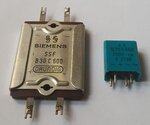schmitt trigger
Advanced Member level 5

My first electronic project that worked, a small audio amplifier, I used a scavenged selenium rectifier.
I also repaired a couple of radios that used them.
On one instance, one blew up and the smoke was nasty.
I later learned that these rectifiers were highly poisonous.
Did you ever came across one?
I also repaired a couple of radios that used them.
On one instance, one blew up and the smoke was nasty.
I later learned that these rectifiers were highly poisonous.
Did you ever came across one?


